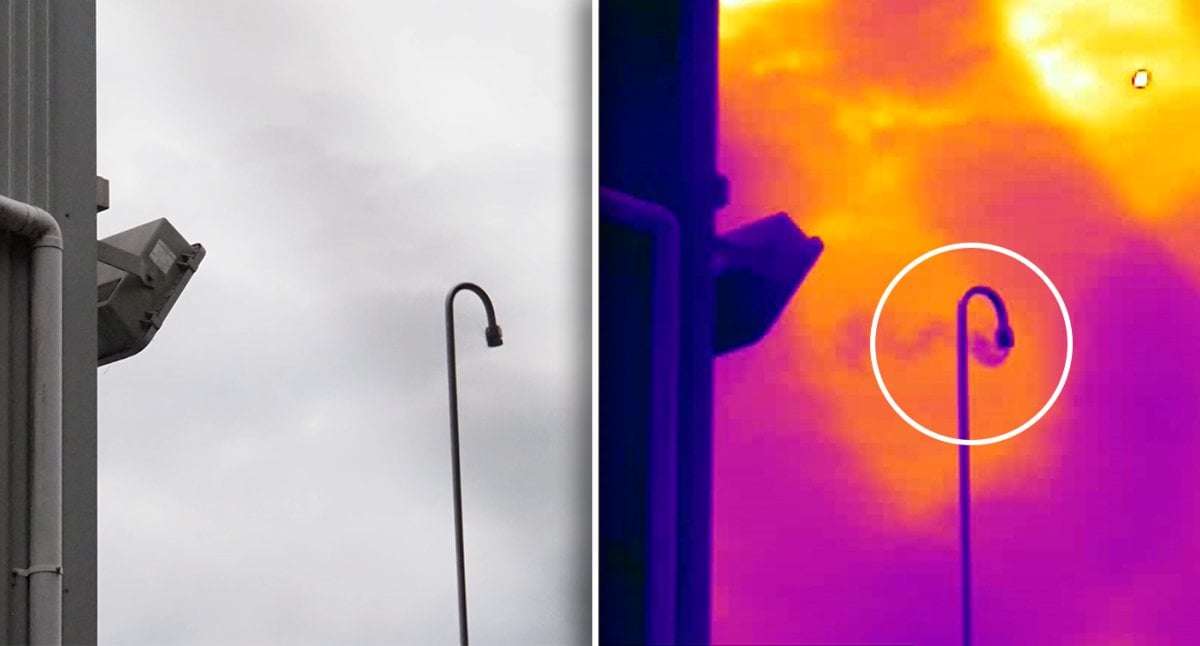You've probably seen thermal imaging cameras used in the Predator movie series to locate people hidden in the South American jungle.
Now thousands of kilometres away in regional NSW and Queensland, similar technology has been utilised to locate invisible pollution wafting from coal seam gas pipes. Using optical gas imaging it was possible to reveal the infrared energy emitted by methane as it is released into the atmosphere.
Video of these emissions was released following a joint investigation by the Australian Conservation Foundation (ACF) and global non-profit Clean Air Task Force. They reported seeing gas escape from 100 sources at 35 industrial sites which they described as “alarming levels of climate-damaging gas pollution”.
At Jemena's Hexham industrial site, investigators used infrared cameras to examine methane emissions which are invisible to the naked eye. Source: ACF
Facilities operated by Australian energy giant Santos and Singapore’s Jemena were among those tested, but it was Origin’s Talinga and Condomine gas fields that were singled out by one investigator as the “most shocking”.
“Wherever I pointed my camera, I saw methane pouring out of the equipment, sometimes from three to four different point sources,” Clean Air Task Force thermographer Théophile Humann-Guilleminot said.
“In times of heated debates on energy cost, seeing all this gas wasted and supercharging climate change is deeply worrying.”
How did the gas companies respond?
While conservationists are ringing alarm bells at the situation, the gas producers have questioned the investigation’s findings, arguing their equipment is working as it’s designed to.
"There is no evidence that the ACF’s work is based on sound science, it has provided scant detail on its methodology and its results have not been replicated by regulators or qualified independent experts," a Santos spokesperson told Yahoo News Australia.
Jemena and Origin added that some machinery is supposed to vent gas as part of its safe operating procedure.
“Some use gas to power their instrumentation, to open and close valves, resulting in small amounts of gas being vented,” an Origin spokesperson said.
Do the gas companies regularly test their pipes?
Santos said it "responded immediately" to a letter from ACF last week and checked its pipes. "No leaks were detected," it said. The company maintains government testing in July and independent testing in May reached the same conclusion.
Jemena said it will be reviewing ACF’s findings against its own measurements as well as international best practice.
Origin added it has surveyed the wells photographed by ACF over the last six to 10 months and concluded they are “operating in line with their design”.
Methane is over 25 times as potent as carbon dioxide in trapping heat.
In 2022, Australia joined 120 other countries in agreeing to the Global Methane Pledge.
Agriculture, mining and gas are the major methane contributors in Australia.
Methane could be responsible for 30 per cent of the global temperature rise since industrialisation.
It is naturally an odourless and colourless gas and doesn't impact human health at low levels.
Are the gas companies trying to improve methane emissions?
Origin said it is working to convert older well instrumentation that emits gas to machines that use compressed air or electrification in order to reduce operational emissions.
Jemena said it takes the issue of gas leakage “seriously”, and that it has procured new gas detection technology to give greater insight into the problem. “When leaks are detected we work to resolve these as quickly and safely as practical,” a spokesperson said.
ACF is not convinced by coal seam gas producer claims they are working to industry standards, saying this “does not absolve them” of continuing to release methane.
“They are freely releasing an extremely potent greenhouse gas into the atmosphere. We are in a climate emergency,” investigator Annica Schoo said.
The Federal Labor Government supports the expansion of Australia's coal seam gas industry, and has supported projects like the hotly contested Narrabri project.
ACF is urging it to establish a methane action plan that requires industry to accurately measure and report its methane emissions.
Ms Shoo said Santos had responded to their queries and she looks forward to meeting with the company to discuss the issue further.
Do you have a story tip? Email: [email protected].
You can also follow us on Facebook, Instagram, TikTok and Twitter and download the Yahoo News app from the App Store or Google Play.

godintraining on August 9th, 2023 at 03:38 UTC »
youtube this is a great Australian YouTuber, in this video he explains in his typical Aussie style that the gas runaways from the mines are more damaging to the environment than all the cars in Australia combined.
Also as those emissions are concentrated in few specific locations, they could be addressed much more efficiently than a wide spread emission channel like automobiles.
Of course Australia is a special case, big land with relatively fewer cars, in US and Europe the math would be different. But still pretty sobering.
jondoesunknowntwin on August 9th, 2023 at 01:24 UTC »
New legislation to prohibit thermal imaging of fossil fuel infrastructure introduced to parliament in 3..2...1.
NormP on August 9th, 2023 at 00:38 UTC »
They can spot that from space in great detail nowadays by remote sensing. Problem though is what happens then.